And yet, 2009 brought my personal pick for the best cinematography of the decade. Quite the paradox, I know.
So a note on that. Anthony Dod Mantle's work on Lars Von Trier's "Antichrist" was the most compelling, the most thematically resonant, the most daring work of the last 10 years. But when it came to putting together my list, I could not, for the life of me, decide on an image that would make a solid entry from the film.
To be perfectly honest, I can't even decide on one that stands out as a specific piece of identity for its visual aesthetic. One possibility would have been quite X-rated, while a handful of others seemed too much of a piece with an overall vision to be singled out. So the film is not on the list.
At the end of the day, however, I came around to a streamlined, varied collective that represents, for me, a nice cross-section of visions, genres and, certainly, budgets. We've once again rounded up the perspectives from the DPs recognized this year, though two instances saw a necessity to quote the director rather than a proper cinematographer. But we'll get into those tomorrow.
For now, let me offer the same sentiment I did last year: I look forward to doing this each and every year I'm cranking out copy for your reading pleasure (or displeasure). In my view, it is one of the best ways I can commemorate the technicians that so often find themselves overlooked this time of year. Thanks for your patience as I put it together, and I hope you enjoy the list.
Without further ado…
#10

"TRANSFORMERS: REVENGE OF THE FALLEN"
Director of Photography: Ben Seresin
The shot wasn't specifically storyboarded, although there was extensive pre-visualization for the rest of the scene. The bottled wall was planned, as it is typical in the Middle East. I tried to create a feeling in the room that would give a sense of safety, and that contrasted with the expanse, scale and danger of outside. I could write a book on working with Michael. Basically, he fluctuates from totally controlling to handing things over. Having said that, the aesthetic of the movie is very much his. He feels very comfortable with his bold style and is generally disinclined to experiment with new approaches.
–Ben Seresin
You won't find me springing outright for mere aesthetic beauty when it comes to this column all that often, but in the case of "Transformers: Revenge of the Fallen," I couldn't resist this composition. In and of itself, it says little about the narrative via visual storytelling, but it is nevertheless an expertly crafted frame, impeccably lit and oozing a certain sense of dread.
Of course, it helps to be photographing a face such as Megan Fox's. But the way the art direction emphasizes her eye color and the way the lighting manages to delicately kiss certain elements within the frame, it grabbed me from the first moment I saw it in the trailer. I knew I'd have to find a place for it on this collective.
Michael Bay's films have a certain music video/commercial aesthetic derived from the filmmaker's time in those trenches. Sometimes the work seems bathed in cliche, while other times, I have to say — in all seriousness — there is a fetching visual tendency that is quite unique. This smoothly conceived image is an example of those two conflicting visual identities being reconciled in an attractive vision.
#9
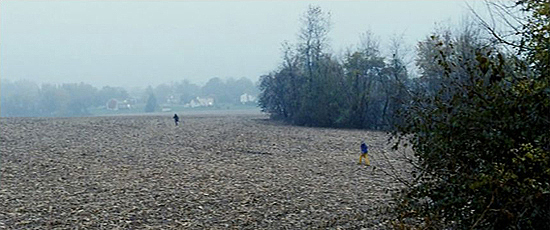
"THE LOVELY BONES"
Director of Photography: Andrew Lesnie
Coming fresh from one of the most vital experiences of a young girl's life (first love) and past an energetic expression of youthful energy on the soccer field, the shot smoothly brings us to the close of one chapter and the beginning of the next. By craning up we draw on the film memory of this move as a closing motif, while also using it to introduce the arena for the coming events. The audience are already aware of the conclusion and have seen Harvey in the field at night, so the transition from a colorful environment with contrasting colors to a monochromatic desolute, denuded cornfield is smooth but immediately gets your mind racing.
–Andrew Lesnie
One of the most vibrantly photographed films of the year was Peter Jackson's critically maligned "The Lovely Bones." Plenty of credit is due, of course, to Jackson's limitless imagination, but his lenser of choice as of late, Andrew Lesnie, has had a pivotal role in bringing the director's vision to the screen since they began their collaboration on the "Lord of the Rings" franchise nearly a decade ago.
Settling on a single image was a chore, if only because it is the overall assemblage, more so than the individual elements, that is most visually arresting for me. I ultimately kept settling back on a haunting crane shot that couldn't be more eloquently described than Lesnie does in the quote above. Moving from the vibrant, rich colors of afternoon to the fog-drenched desolation of the film's upcoming dramatic swing, the movement is foreboding and thematically powerful.
Lesnie and Jackson were intrigued with this area of Pennsylvania having an interesting juxtaposition of working fields and suburbs. They spent quite a lot of time talking through the sequence, putting lights in the distant houses and filming late in the afternoon to make sure they registered, finding a balance between telegraphing the story and setting the mood of the scene. I think they reached an artful balance.
#8
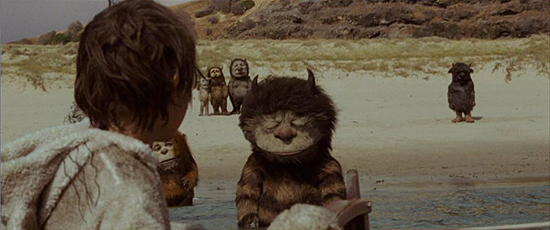
"WHERE THE WILD THINGS ARE"
Director of Photography: Lance Acord
Getting the suit performers in the water was a challenge because if the suits filled up with water, it would keep them under water. The location, Bush Ranger's Bay on the Mornington Peninsula in Australia, it has like 8-10 foot waves washing ashore. Pirates in the early 1800s would build fires along the coastline to lure ships into thinking there were settlements there, and it would cause the ships to shipwreck and they would go out and pillage the ships. It was a real miracle that it was the only day of being at that location for close to three weeks when there were hardly any waves. The ocean went completely flat.
–Lance Acord
Cinematographer Lance Acord has been working in the industry for over a decade, and much of that time has been spent as a collaborator with director Spike Jonze. As much as any esteemed director-lenser combo, their work together has established a visual identity unmistakably distinguished and unique.
I was not as taken with Jonze's "Where the Wild Things Are" as a whole as much as a great many viewers. However, there were many moments along the way that carried an emotional heft which certainly reminded me that Jonze is one of the best in the business at drawing the most impact out of an image.
So it was that the shot I chose from the film was, for me — working in tandem with Carter Burwell's measured score, of course — one of the more affecting moments of the year. Young Max, leaving the escapist world of his creation behind, stares longingly at a distraught Carol, the manifestation of all the raw emotions and dispositions a young child is capable of. In some way, it reads as an au revoir to youth. In others, an understanding that it will never leave you. The frame seems to linger just long enough to allow for such consideration of the image's implications.
#7
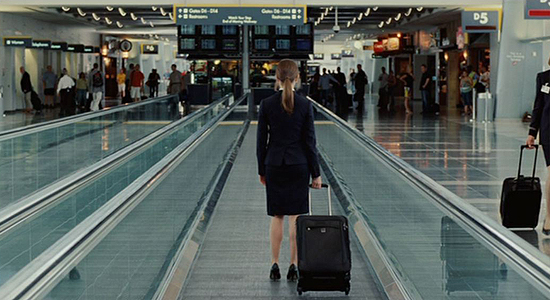
"UP IN THE AIR"
Director of Photography: Eric Steelberg
We had just finished shooting and we were moving between locations at the airport. We were walking by this walkway and Jason said, 'Do we have Anna? I want to do a shot of Anna on this walkway really quick. Can we do that?' We didn't really have permission, so he said let's talk with the airport and see if we can do it. I think he knew where he would use it tonally but he said, 'Oh, you know what, I do actually need a cutaway for Anna at the end of the movie.' It was literally spur of the moment, walking by, seeing the opportunity. And it kind of reminds everybody of her journey as well.
–Eric Steelberg
It's not always the aesthetic beauty of a shot or its various technical complexities that dazzles. It can be as simple as a concise image that speaks a thousand words based on how a filmmaker and his or her editor decides to implement it within the narrative. And that was the case with the image I chose from Jason Reitman's "Up in the Air."
Shot by longtime Reitman cinematographer Eric Steelberg, the film is trademark of the duo with its lack of fussy imagery that nevertheless carries a certain thematic weight. The quote above lays out the serendipitous circumstances by which the shot was acquired, but it's lovely to know that it didn't go to waste.
Reitman is often assumed to be a filmmaker lacking a discernible visual thumbprint, but spend more than a few minutes with any of his creative collaborators and it becomes obvious the artistry is efficient but substantial. I love this shot because, in my opinion, it encompasses that aspect of his work.
#6

"THE ROAD"
Director of Photography: Javier Aguirresarobe
John Hillcoat, from the beginning, was very confidant in me. I could work with a lot of freedom. This shot was an improvisation. It wasn't planned. The movie doesn't have too many interior scenes and this was something we discovered right there on the set. Most of the movie wasn't storyboarded and we were really glad that this was a shot that could show like a shadow without a specific shape that is being erased and it reflects the character and what he's feeling at that moment and accentuates the drama. The water is, in a sense, erasing the past. I think it's a really powerful moment in the story.
–Javier Aguirresarobe
Lenser Javier Aguirresarobe has had quite the career in his homeland of Spain, but it wasn't until he was tapped by director Alejandro Amenabar to photograph the moody 2001 thriller "The Others" that domestic audiences got a significant look at his work. After collaborating with filmmakers like Pedro Almodovar and Woody Allen, and now with BAFTA-nominated work in "The Road," he seems poised to be an awards season player one of these days.
There wasn't a lot about John Hillcoat's adaptation of Cormac McCarthy's novel that affected me on the whole, but one sequence in particular grabbed me immediately for its sense of aching nostalgia. The moment is capped off by this image, reflected in a decrepit television set as a drop of dirty water streaks down the mirrored face of the protagonist. It initially seems like a bit of opportunistic aestheticism but is actually a potent piece of imagery for the reasons Aguirresarobe states above.
If one can say anything about the film, it is that it builds an incredible sense of place and atmosphere. One can almost feel the grime and decay of a lost world. Much of that credit, no doubt, is due to Aguirresarobe's contribution.
Before getting into the top five, however, I'd like to spotlight a few examples that almost made the cut but just missed.
First and foremost, "Inglourious Basterds" is obviously a favorite around these parts. Robert Richardson, as we've come to expect, offered a wonderful visual context for Quentin Tarantino's story, and though none of the shots particularly spoke to me on a thematic level, it is nevertheless worth pointing out the aesthetic impact of Shoshana's cackling specter projected on smoke and the gripping crane down to reveal a hiding Jewish family in the countryside of Nazi occupied France.
One of the unsung heroes of the season in the field was Greig Fraser, whose soft touch gave Jane Campion's "Bright Star" a beautiful identity. The shot that has always stuck out for me was Fanny Brawne on her bed, intoxicated with love as a strong afternoon breeze blows in her window.
I was also captivated by the visual aesthetic of Tom Ford's "A Single Man," shot by Eduard Grau. The disorienting nature of an image featuring a "Psycho" poster always stuck out to me. It is also worth noting a shot of Jeremy Renner standing in a grocery aisle in "The Hurt Locker," speaking volumes about his character's disposition, lost in a safe world (though lenser Barry Ackroyd was not involved with the U.S. portion of the shoot, it should be noted). And I always smile when I see the image in "Crazy Heart" of a passerby reflected in the window of Bad Blake's wrecked suburban, rushing down the hill to help.
Finally, Roger Deakins should never go unmentioned in a discussion of cinematography, and what he did on the Coens' "A Serious Man" was trademark organic beauty. The image that sticks out to me is, ultimately, the final image of a tornado bringing the arbitrary wrath of the film's themes to a tangible form.
In any case, it was, as always, a joy digging through the year's visuals and coming up with this collective. Even in a weak year for the medium, there are always gems worth spotlighting. I hope you enjoy the second half, so let's get down to it.
The top five shots of 2009…
#5
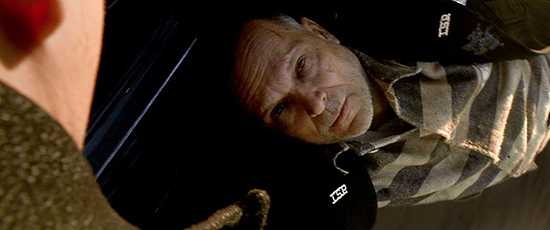
"PUBLIC ENEMIES"
Director of Photography: Dante Spinotti
It was very complicated from the point of view of visual effects. They rigged the car so that it was trailing sort of a platform on which the actor was lying and there was a green screen on top of it and then shot the background of the road and all the dust. So it looked like the guy was actually pulled by the car on the road itself. Dillinger loses his friend and mentor and teacher in this scene and the fact that something goes terribly wrong with the prison break probably sets the tone of the rest of the story. Criminality was going in a different direction. The look between the two actors is really wonderful and the moment is definitely very emotional.
–Dante Spinotti
Dante Spinotti first came to America in the early 1980s. He soon had a professional relationship with producer Dino De Laurentiis, and after a pairing on one project fell through, De Laurentiis told Spinotti, "Don't worry, I'm going to put you together with a talented young director." That director was Michael Mann, the film was "Manhunter," and the rest is history.
"Public Enemies" marks the duo's fifth collaboration (and Spinotti actually got a call for "Miami Vice," but couldn't commit). Spinotti's work on the film has largely been debated for the use of digital photography, but none of that really figured in to my perception of one of the best shots of the year.
After breaking his comrades out of prison in the film's early moments, John Dillinger looks on as his friend and mentor is gunned down. What makes the moment powerful and the image arresting is that the characters get this final, aching goodbye as Dillinger's friend is dragged alongside the getaway car. I've never seen a shot like that and it became one more reminder that Mann knows how to draw a lot of emotion out of a single unique frame.
#4
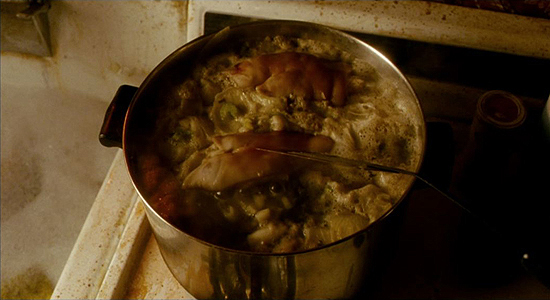
"PRECIOUS"
Director of Photography: Andrew Dunn
A lot of what cinematographers do has a greater meaning than the shot itself. This shot is of course only of value within the context of the storytelling. It reflects her situation. The apartment is a prison and her life is a prison and within that is this prison, this cauldron of bubbling mess. We were getting ready to move off that set and we knew we needed an actual storytelling point. It's absolutely imperative that you get these little moments of storytelling. You don't always know at the time of shooting what will be necessary and valid during the editing process, but it's absolutely vital that you get all the ingredients so that the editor has choices.
–Andrew Dunn
Lee Daniels brought a stylistic sense to "Precious" that few would have anticipated given both the material and his career to date. But what resulted was a flourish of creative storytelling and an affecting drama that has a singular, penetrating vision. Much of that vision is owed, in no small part, to British cinematographer Andrew Dunn.
One of the key sets on the shoot was, of course, Precious and her mother's New York apartment. The goal was to shoot those scenes like the hot bed of tension they were, and one instance early on in the film stuck out to me as an intriguing commentary on everything from stereotypes to health concerns to, most definitely, thematic context.
Dunn's quote above really tells the tale. The shot is deceptively simple: a boiling pot of pig's feet. But what seems like a simple cutaway insert holds so much more information, and its usage in the editorial flow of the scene becomes a mark of detail-oriented visual storytelling.
#3
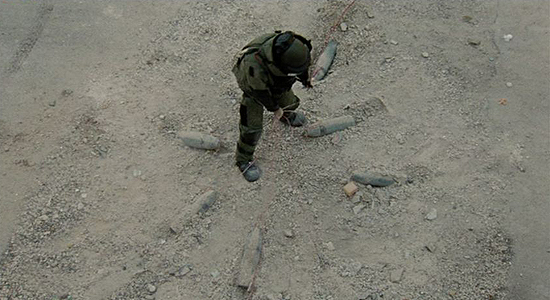
"THE HURT LOCKER"
Director of Photography: Barry Ackroyd
It's very informational in a lot of ways. It's kind of a symbolic image as well, which I think gives it its strength. The obvious thing was to show this from above to give this kind of web surrounding him, which I think is metaphorical for his position, but also the moment of ecstasy at the center of this thing, it's like he's caught in a spider's web. And it's almost like an impossible place to be, so I think it's a little bit mystical as an image. You wouldn't get yourself in the center of such danger, but that was obviously the character. He was prepared to do that, which made him different to the other guys, and I think ultimately that's what the film's about.
–Barry Ackroyd
Lenser Barry Ackroyd started his career back in the early 1980s. After paying his dues in the world of television, he hooked up with director Ken Loach for a number of projects before finally breaking onto the scene Stateside with Paul Greengrass's "United 93." And it was that film, in fact, with its blend of intimate drama and guerrilla-like docudrama filmmaking that caught director Kathryn Bigelow's attention.
With "The Hurt Locker," Ackroyd worked with Bigelow to develop a singular frenetic style meant to emulate the high tension of the profession being dramatically documented. But the image that stood out as iconic in the face of all of those multiple cameras and set-ups was a calmer perspective, and one that helped to define the visual identity of the film.
Staff Sergeant William James, stuffed into an ominous bomb suit and having diffused one IED already, discovers he's not out of the forest yet. As he yanks on a chord connected to a slew of other devices, he lifts the arrangement out of the dust, yielding one hell of a gasp-inducing moment. Intriguingly enough, given the weight of a typical IED, this is something a man wouldn't have had the strength to do, but it makes for high visual drama nevertheless.
#2
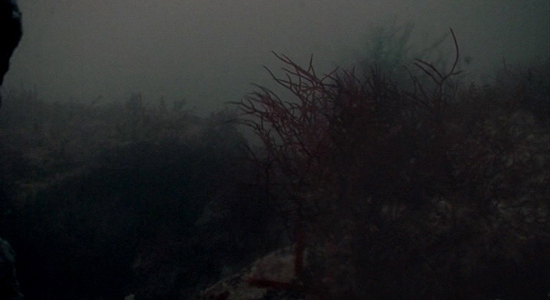
"THE COVE"
Director of Photography: Brook Aitken
We had four hours and five minutes of drive time. It was a prototype camera, then we had to have a battery specially made. So the inside of this camera, the lithium batteries were around it, so it looked just like dynamite. We tried it once and it didn't work because we had gotten it too early, and the second time we got it, it happened in the last five minutes as we were running out of hard drive space. It's actually a dissolve. We sped it up so that probably about a minute and a half got reduced to maybe five seconds. We didn't mess with the color at all on that stuff, and that honesty was really important to me in that shot.
–Director Louie Psihoyos
Louie Psihoyos's "The Cove" was a feat of cinematography from the get-go. The film is, after all, about a covert operation to capture vital footage that could galvanize and help start an activist movement. The planning that went into getting that footage, the building of casings to hide cameras, the prototypes unitized in order to get large amounts of digital footage, is an undeniable accomplishment.
One image in particular really stood out to me when I first saw the film, as I'm sure it did many others. One of the underwater cameras captures, in stark detail, a flood of dolphin blood filling the screen and turning the water crimson red. The impact is helped along, no doubt, by the use of audio over the shot, the screams of terror from the dolphins filling the soundtrack.
Psihoyos put together a wonderful team for his film and much credit should be given, obviously, to DP Brook Aitken. But when it came to this particular moment, I thought it would be best to get the director's perspective, given the overall guerrilla group effort. And being a former National Geographic still photographer himself, I knew he would have plenty to offer to a discussion of one of the film's most arresting visuals.
#1

"PARANORMAL ACTIVITY"
Director of Photography: Oren Peli
I literally spent months playing around with it and tweaking it, finding the right angle and the right colors, the right filters. It took a lot of effort. Once I got the positioning I had to figure out the lighting. It had to look natural but not like we were trying to be creepy. So I had to create a source of light that allows you to see what's going on but not too clearly. I took a light and put it in the corner facing the wall, used filters to give it a little more bluish look and increased the contrast a little bit more. I knew this was going to be the standard shot we were going to use. I didn't want to keep using different shots with drastically different angles.
–Oren Peli
The year's DIY success story also happened to feature one of the most effective images of the year. Oren Peli's "Paranormal Activity" was certainly no traditional production, with a handheld camera and a few actor friends filling out the crew. The director himself essentially served as his own cinematographer, though mostly it was the job of actor Micah Sloat to capture the film in a home video fashion. One shot in particular was a bit of an exception, and it immediately became the visual identity of the film.
A standard still image used in the narrative to capture what is happening to a haunted couple as they sleep at night, the composition accomplished so much with minimal lighting, some creative production design and a wide angle lens. To the right, you have your sleeping couple, to the left, a door and, further, a hallway that plays an integral part in the plot. However, it is one thing to be efficient with the way you choose to shoot a scene. It is another thing entirely for your composition to take on a life of its own, capable of raising the hairs on the back of one's neck as a simple production still.
That is what Peli managed with his shot. He tried a few different things after renovating the house for his purposes, like placing the bed on the wall to the right, for instance. But ultimately he settled on this composition, and it couldn't have been more perfect. It is, for my money, the best shot of 2009.
The top 10 shots of 2009
No comments:
Post a Comment